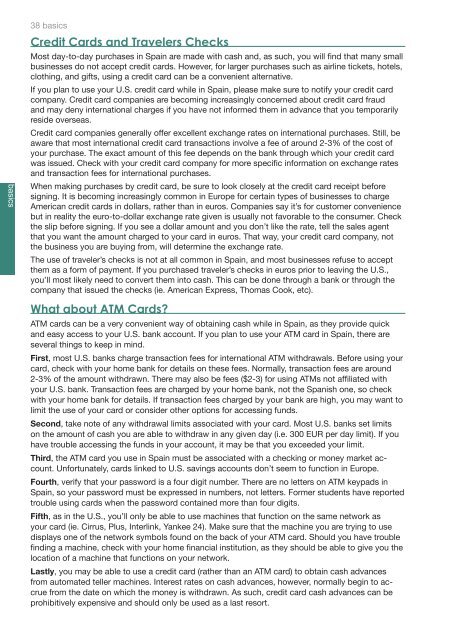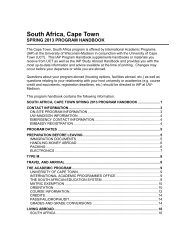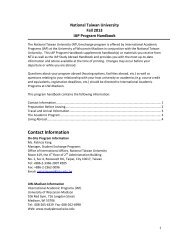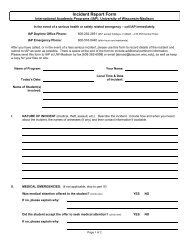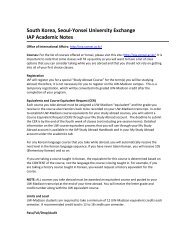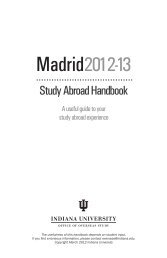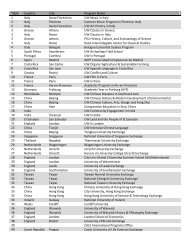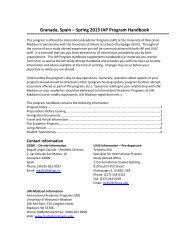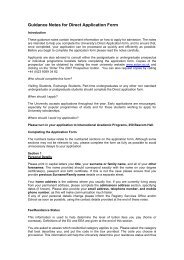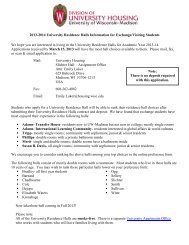teach in spain - UW Study Abroad
teach in spain - UW Study Abroad
teach in spain - UW Study Abroad
You also want an ePaper? Increase the reach of your titles
YUMPU automatically turns print PDFs into web optimized ePapers that Google loves.
asics<br />
38 basics<br />
Credit Cards and Travelers Checks<br />
Most day-to-day purchases <strong>in</strong> Spa<strong>in</strong> are made with cash and, as such, you will f<strong>in</strong>d that many small<br />
bus<strong>in</strong>esses do not accept credit cards. However, for larger purchases such as airl<strong>in</strong>e tickets, hotels,<br />
cloth<strong>in</strong>g, and gifts, us<strong>in</strong>g a credit card can be a convenient alternative.<br />
If you plan to use your U.S. credit card while <strong>in</strong> Spa<strong>in</strong>, please make sure to notify your credit card<br />
company. Credit card companies are becom<strong>in</strong>g <strong>in</strong>creas<strong>in</strong>gly concerned about credit card fraud<br />
and may deny <strong>in</strong>ternational charges if you have not <strong>in</strong>formed them <strong>in</strong> advance that you temporarily<br />
reside overseas.<br />
Credit card companies generally offer excellent exchange rates on <strong>in</strong>ternational purchases. Still, be<br />
aware that most <strong>in</strong>ternational credit card transactions <strong>in</strong>volve a fee of around 2-3% of the cost of<br />
your purchase. The exact amount of this fee depends on the bank through which your credit card<br />
was issued. Check with your credit card company for more specific <strong>in</strong>formation on exchange rates<br />
and transaction fees for <strong>in</strong>ternational purchases.<br />
When mak<strong>in</strong>g purchases by credit card, be sure to look closely at the credit card receipt before<br />
sign<strong>in</strong>g. It is becom<strong>in</strong>g <strong>in</strong>creas<strong>in</strong>gly common <strong>in</strong> Europe for certa<strong>in</strong> types of bus<strong>in</strong>esses to charge<br />
American credit cards <strong>in</strong> dollars, rather than <strong>in</strong> euros. Companies say it’s for customer convenience<br />
but <strong>in</strong> reality the euro-to-dollar exchange rate given is usually not favorable to the consumer. Check<br />
the slip before sign<strong>in</strong>g. If you see a dollar amount and you don’t like the rate, tell the sales agent<br />
that you want the amount charged to your card <strong>in</strong> euros. That way, your credit card company, not<br />
the bus<strong>in</strong>ess you are buy<strong>in</strong>g from, will determ<strong>in</strong>e the exchange rate.<br />
The use of traveler’s checks is not at all common <strong>in</strong> Spa<strong>in</strong>, and most bus<strong>in</strong>esses refuse to accept<br />
them as a form of payment. If you purchased traveler’s checks <strong>in</strong> euros prior to leav<strong>in</strong>g the U.S.,<br />
you’ll most likely need to convert them <strong>in</strong>to cash. This can be done through a bank or through the<br />
company that issued the checks (ie. American Express, Thomas Cook, etc).<br />
What about ATM Cards?<br />
ATM cards can be a very convenient way of obta<strong>in</strong><strong>in</strong>g cash while <strong>in</strong> Spa<strong>in</strong>, as they provide quick<br />
and easy access to your U.S. bank account. If you plan to use your ATM card <strong>in</strong> Spa<strong>in</strong>, there are<br />
several th<strong>in</strong>gs to keep <strong>in</strong> m<strong>in</strong>d.<br />
First, most U.S. banks charge transaction fees for <strong>in</strong>ternational ATM withdrawals. Before us<strong>in</strong>g your<br />
card, check with your home bank for details on these fees. Normally, transaction fees are around<br />
2-3% of the amount withdrawn. There may also be fees ($2-3) for us<strong>in</strong>g ATMs not affiliated with<br />
your U.S. bank. Transaction fees are charged by your home bank, not the Spanish one, so check<br />
with your home bank for details. If transaction fees charged by your bank are high, you may want to<br />
limit the use of your card or consider other options for access<strong>in</strong>g funds.<br />
Second, take note of any withdrawal limits associated with your card. Most U.S. banks set limits<br />
on the amount of cash you are able to withdraw <strong>in</strong> any given day (i.e. 300 EUR per day limit). If you<br />
have trouble access<strong>in</strong>g the funds <strong>in</strong> your account, it may be that you exceeded your limit.<br />
Third, the ATM card you use <strong>in</strong> Spa<strong>in</strong> must be associated with a check<strong>in</strong>g or money market account.<br />
Unfortunately, cards l<strong>in</strong>ked to U.S. sav<strong>in</strong>gs accounts don’t seem to function <strong>in</strong> Europe.<br />
Fourth, verify that your password is a four digit number. There are no letters on ATM keypads <strong>in</strong><br />
Spa<strong>in</strong>, so your password must be expressed <strong>in</strong> numbers, not letters. Former students have reported<br />
trouble us<strong>in</strong>g cards when the password conta<strong>in</strong>ed more than four digits.<br />
Fifth, as <strong>in</strong> the U.S., you’ll only be able to use mach<strong>in</strong>es that function on the same network as<br />
your card (ie. Cirrus, Plus, Interl<strong>in</strong>k, Yankee 24). Make sure that the mach<strong>in</strong>e you are try<strong>in</strong>g to use<br />
displays one of the network symbols found on the back of your ATM card. Should you have trouble<br />
f<strong>in</strong>d<strong>in</strong>g a mach<strong>in</strong>e, check with your home f<strong>in</strong>ancial <strong>in</strong>stitution, as they should be able to give you the<br />
location of a mach<strong>in</strong>e that functions on your network.<br />
Lastly, you may be able to use a credit card (rather than an ATM card) to obta<strong>in</strong> cash advances<br />
from automated teller mach<strong>in</strong>es. Interest rates on cash advances, however, normally beg<strong>in</strong> to accrue<br />
from the date on which the money is withdrawn. As such, credit card cash advances can be<br />
prohibitively expensive and should only be used as a last resort.


